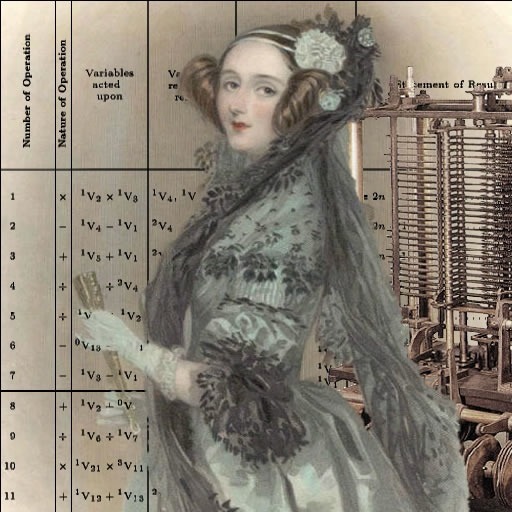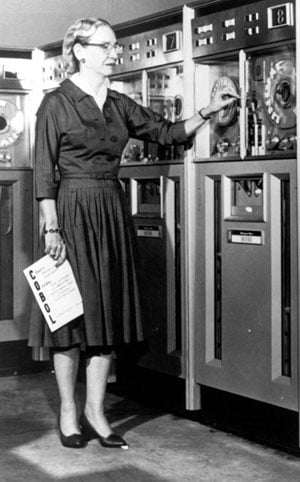This past week of February was National Engineers Week, and it’s always an excellent time to learn about different engineers today as well as those whose shoulders we stand on. I haven’t practiced engineering as a professional in over eight years, but I still work with engineers and structural engineering every day at Bentley Systems.
I wanted to post a bit on some of the history of software engineering and, in particular, just how much women have contributed and really created that discipline.
Ada Lovelace

Ada Lovelace pictured with her table of algorithms created as an example code
Lovelace is widely recognized as having created the very first computer code language, when transcribing in her shorthand some mathematics to use on Charles Babbage’s difference engine. Stephen Wolfram did some research on Lovelace’s life and wrote a fascinating article on her life and work.
WWII Computers
Prior to the general adoption of digital computers, a “computer” was actually a human person who sat and did calculations all day. These were almost without exception women, many of whom had degrees in mathematics but were not able to continue on in the field due to their gender. During World War II, when the US Army was researching the first digital computer — the ENIAC, a group of these women who had been calculating munition trajectories were hired on to encode the same calculations into that computer. They wrote the computer code and the debugging for the first computer.
The excellent documentary “Top Secret Rosies“1 contains many first-person interviews with these women and the men who fought in WWII, using their work everyday in the war.
Katherine Johnson
“She was a computer when computers wore skirts.”
And Katherine Johnson was just about the best. So good, in fact, that when digital computers were being used to calculate the mission trajectories for the first moon landing, John Glen insisted that they be checked by Johnson first2.
Makers.com has a wonderful set of video interviews about her career.
Last year, Johnson was awarded a Presidential Medal of Freedom —one of the two highest civilian honor this country bestows— in honor of her accomplishments as well as her being a role model for women and people of color.
Grace Hopper
Rear Admiral Grace Hopper was an early computer scientist who is probably best known for having discovered an actual bug (a moth) in a piece of computer equipment (a printer). However, it was her contribution of creating the first digital compiler for taking human-readable code and converting it to machine language that was truly a remarkable achievement.
As a I told my after school coding club kids last Fall, anytime you are debugging code so a computer can understand it, think about Admiral Hopper!
Margaret Hamilton

Margaret Hamilton standing next to listings of the Apollo Guidance Computer (AGC) source code (Courtesy Wikipedia)
While Katherine Johnson and others had calculated the trajectory for the Apollo mission, the spacecraft itself now had digital computers on board. Margaret Hamilton was the lead software engineer —a phrase coined by Anthony Oettinger and then put into wide use by Hamilton— for the Apollo craft’s operating system. Her foresight into operation priorities saved the day when a radar system malfunctioned but the guidance system architecture still landed the lunar module. She founded Hamilton Technologies in 1986.
Today
I can’t help but wonder that men haven’t simply co-opted the role of software engineer from women once it became clear that software was a worthwhile endeavor. However, there are many great women engineers practicing today, in both software and other engineering disciplines. I have the privilege of working with many at Bentley Systems. However, we’ve done a great disservice to young women in creating a culture that fails to encourage women into science, technology, engineering, and mathematics careers. STEM programs go a long way to help right this, but I think we also need to recognize that women have managed to create much of the modern world we know today, particularly in the field of software. And this in spite of the uphill climb many of these women faced in just finding work at all!
So in honor of engineers week, let’s be sure to let young women know that not only is their a future in STEM for them, but there is also an amazing past to be proud of!

“Coding is for girls” by Anne McGraw
Further Reading
- Computer Programming Used to be Women’s Work
- The Forgotten Female Programmers Who Created Modern Tech
- Researcher reveals how “Computer Geeks†replaced “Computer Girlsâ€
- Mothers of Technology: 10 Women Who Invented and Innovated in Tech
- At the time of this writing, it was on DVD only and not especially easy to find. I was able to rent it from Netflix and it may be for sale on Amazon. I highly encourage anyone interested in tech, history, or warfare to watch it. [↩]
- Always check the computer kids! It’s only as good as the programmer. [↩]

